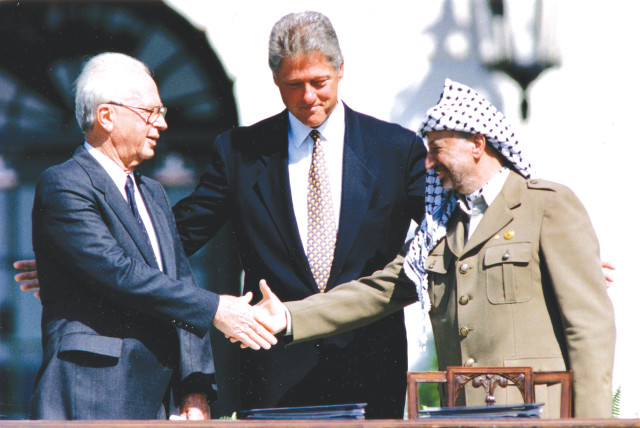After the war: A two-state solution? - opinion

The phrase “two-state solution” is constantly being repeated, but is it realistic?
In their plan for “the days after” the current war between Israel and Hamas, both US President Joe Biden and Secretary of State Antony Blinken are reasserting their belief in the return of the Palestinian Authority (PA) to replace the Hamas terror organization in governing the Gaza Strip, and in the necessity to reach a “two state solution” as the outcome of the Palestinian-Israeli dispute.
Such an outcome is also echoed by international leaders and organizations and, as in the past, is again being bandied about as a form of collective and generalized wishful thinking as the only panacea to the Palestinian-Israeli dispute.
However, there appears to be a distinct lack of awareness of the background, history, practical implications, and the feasibility of a two-state solution in the context of the history and changing realities of the dispute.
By the same token, there appears to be a collective and naïve illusion that the corrupt and ineffective PA could be capable of governing the Gaza Strip.
The phrase “two-state solution” is constantly being repeated despite the fact that the concept of two states as a solution to the conflict has never been officially accepted as the agreed solution either by Israel or by the Palestinian leadership.
On the contrary, as agreed in the still-valid Oslo Accords, the permanent status of the territories remains an open negotiating issue. As such, repetition of the call for a two-state solution prejudges the outcome of the negotiating process and seriously underestimates the flawed capabilities of the PA in its present form.
Is a two-state solution possible?
Clearly, any concept of two states that would include the establishment of a Palestinian state alongside Israel could only emanate from direct negotiations between Israel and a unified and fully representative Palestinian leadership. It could not be a result of any off-the-cuff political declaration or resolution issued by the UN or by any other source.
Nor could such a solution emerge from vague and generalized calls from international leaders for a two-state solution as a form of collective wishful thinking.
AS HAS been the case with the Hamas terror administration that usurped governance of the Gaza Strip from the Palestinian Authority, a politically and economically unstable and non-viable Palestinian entity would be open to manipulation by Iran and other foreign states and terror elements, and as such could never be acceptable to Israel or to the international community inasmuch as it would constitute a constant threat both to Israel’s security as well as to regional stability.
On the basis of experience from previous agreements between Israel and the Palestinians, any viable, realistic, and permanent solution, whether this be one, two, or three states, a federation, confederation or any other political permutation, will need to include solid international guarantees – legal, political, and security – that such an agreed solution will not be abused, undermined, violated, or abrogated by any future Palestinian entity or regional grouping, and would not constitute a threat to Israel, its sovereignty and to the security of its population.
Before such an end may be achieved, and prior to any serious consideration of any form of a two-state solution, several central issues will need to be resolved.
First and foremost, the replacement of the brutal, Hamas terror administration of the Gaza Strip area with some type of viable, interim, governing framework. This must involve the mobilization of responsible and capable international elements that would oversee the reconstruction of the Gaza Strip area and ensure the humanitarian and economic welfare of its civilian population.
This could be in the form of a new international framework established solely for such a purpose, with regional and other states committed to ensuring stability and capable governance of the Gaza Strip.
Another possibility could be an extended and modified version of one of the already existing international frameworks presently functioning in the area, such as the Multinational Force and Observers (MFO) established by Israel and Egypt to supervise the implementation of the 1979 Egypt-Israel Peace Treaty.
The mandate for such a framework would clearly need to be adapted, and the composition, in addition to the US, would need to be supplemented by regional states committed to peace and stability.
Alternatively, an updated, improved, and adapted version of one of the UN frameworks functioning in the area, such as the UN Interim Force in Lebanon (UNIFIL) could be considered. However, any UN framework has negative connotations in light of the regrettable history of UN involvement in the area, especially as regards UNIFIL which has failed to fulfil its mandate set out in UN Security Council resolution 1701 (2006) of preventing the presence of Hezbollah in proximity to the border with Israel.
Ultimately the decision as to which interim mechanism would be most suitable and effective would depend on concurrence between Israel, the United States, and the international community.
Calls for the restoration of the PA as the governing body in the Gaza Strip are no less naïve and uninformed than those calling for a two-state solution.
This is especially true in light of the corruption rife among the leadership of the PA, its failure to maintain security within the area it governs (Judea and Samaria), and its policies of encouragement and incitement to terror – as well as its financing of terror through payment of salaries to perpetrators of terror and their families.
Only after stabilizing the situation in the Gaza Strip area, including the dismantling of the terror infrastructure and removal of weapons and ammunition, leading to its complete demilitarization – only then could it be possible and propitious to consider in the wider context, a solution to the Israeli-Palestinian dispute.
Such a solution would need to involve a unified responsible Palestinian administration – and not a corrupt one like the PA – that would be fully capable of governance, and of fulfilling its international obligations. Only then would it be possible to consider viable options for solving the dispute – whether this involves one, two, or three states, a federation, confederation, condominium, or co-imperium, or anything else.
It will, of necessity, take time in order to rebuild a modicum of good faith and mutual trust between the parties. This cannot be hurried by flippant, irresponsible and non-informed calls for a two-state solution.
Time will tell.
The writer served as the legal adviser to Israel’s Foreign Ministry and as ambassador to Canada. He was involved in the negotiation and drafting of the peace treaties with Israel’s neighbors and the agreements with the Palestinians. Currently, he directs the international law program at the Jerusalem Center for Public Affairs.
Jerusalem Post Store
`; document.getElementById("linkPremium").innerHTML = cont; var divWithLink = document.getElementById("premium-link"); if (divWithLink !== null && divWithLink !== 'undefined') { divWithLink.style.border = "solid 1px #cb0f3e"; divWithLink.style.textAlign = "center"; divWithLink.style.marginBottom = "15px"; divWithLink.style.marginTop = "15px"; divWithLink.style.width = "100%"; divWithLink.style.backgroundColor = "#122952"; divWithLink.style.color = "#ffffff"; divWithLink.style.lineHeight = "1.5"; } } (function (v, i) { });

